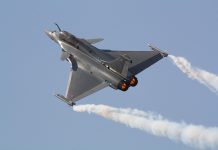
The Russian Buk-M3 Viking anti-aircraft missile system is a highly capable and adaptable defense platform designed to counter a wide array of modern aerial threats. According to Russian manufacturer Rosoboronexport, the system is equipped to intercept advanced threats, including precision-guided munitions, artillery shells, and stealth aircraft such as the U.S. Air Force’s F-22 Raptor and F-35 Lightning II.
The Buk-M3 Viking is the latest iteration of Russia’s long-established Buk family of surface-to-air missile systems, marking a significant advancement in capability. Developed by Almaz-Antey, it is engineered to neutralize a broad range of targets, including cruise missiles, drones, tactical ballistic missiles, and stealth aircraft. It integrates advanced radar, missile, and command technologies into a highly lethal, flexible air defense solution.
Central to the Buk-M3 is its advanced 9A317M launcher, capable of launching six ready-to-fire 9M317M missiles. These missiles are equipped with active radar homing and enhanced guidance systems, enabling improved accuracy and the simultaneous engagement of multiple targets. Each 9A317M can independently target up to six different threats, a notable enhancement over earlier Buk systems. The system offers an engagement range of up to 45 kilometers against cruise missiles and over 70 kilometers for traditional aircraft, with a maximum engagement altitude of 35 kilometers, making it highly versatile in modern air combat.
The Buk-M3’s radar capabilities are a key differentiator, incorporating a multifunction radar that can detect and track more than 100 aerial targets at once. This includes low radar cross-section (RCS) threats such as stealth aircraft, which typically challenge conventional radar systems. The Buk-M3 likely utilizes radar technology derived from Russia’s S-400 and S-500 air defense programs, further enhancing its ability to detect and engage low-observable targets like the F-35 and F-22.
In addition to its radar prowess, the Buk-M3 integrates advanced electronic counter-countermeasures (ECCM), enabling it to operate effectively in electronic warfare environments. The system’s mobility is another critical asset, mounted on a tracked chassis to ensure operational flexibility in a variety of terrains. This allows rapid repositioning, enhancing its survivability and making it more difficult for adversaries to pinpoint and target.
The Buk-M3 is also designed for integration with other Russian air defense systems, such as the S-300 and S-400, forming a layered, networked defense that enhances overall effectiveness. Its automated command and control (C2) system processes data from multiple sensors, prioritizes targets, and assigns them to individual launchers, significantly improving response times and intercept efficiency. Furthermore, the Buk-M3 can link into Russia’s broader Integrated Air Defense System (IADS), creating a unified air defense network.
The system is particularly notable for its ability to engage stealth aircraft, which rely on reduced radar visibility and electronic warfare tactics to evade detection. Through a combination of multi-band radar, networked tracking systems, and data sharing from multiple sources, including ground, airborne, and space-based platforms, the Buk-M3 can effectively detect and engage stealth threats, even in contested environments.
The Buk-M3 also includes capabilities for countering drones, an emerging concern in modern warfare. It is capable of engaging small, low-flying UAVs, further expanding its versatility in responding to a range of aerial threats.
Designed with survivability in mind, the Buk-M3’s components, including launchers and radar units, operate independently with their own power supply, ensuring continued operation in the event of system disruption. Its decentralized architecture, combined with camouflage and decoy measures, enhances its resilience against suppression efforts, such as anti-radiation missile strikes or cyberattacks.
In conclusion, the Buk-M3 Viking is a highly advanced and flexible air defense system that integrates cutting-edge missile technology, radar capabilities, and command systems. Its ability to counter stealth aircraft, perform in electronic warfare environments, and engage a diverse array of threats underscores its critical role in Russia’s modern air defense strategy. The system’s modularity, adaptability, and multi-role capabilities reflect broader trends in air defense, where networked, versatile solutions are becoming increasingly vital.




